Photothermal conversion assisted photocatalytic hydrogen evolution from amorphous carbon nitrogen nanosheets with nitrogen vacancies†
Abstract
Amorphous carbon nitrogen (a-CN) has attracted a lot of attention due to its unique properties, different from those of its crystal form. Here, we demonstrate a near-infrared (NIR) photothermal conversion assisted photocatalytic hydrogen evolution from a-CN with nitrogen vacancies (a-CNN) nanosheets. Experiments suggest that sp2 hybridized C![[double bond, length as m-dash]](https://www.rsc.org/images/entities/char_e001.gif) C structures can be created in a-CNN. These structures, just like small islands, disperse on a-CNN, leading to fluorescence quenching and a superior vis-NIR light absorption. Meanwhile, these structures, like “hot islands”, can generate a stronger NIR photothermal conversion. A series of in situ characterization techniques are developed to clarify the detailed mechanism of photothermal conversion assisted photocatalytic hydrogen evolution. It is found that photothermal conversion can not only accelerate the drift velocity of the photo-induced carrier, but also increase the carrier concentration, which finally promotes the photocatalytic hydrogen evolution. Due to photothermal conversion assistance, the hydrogen production rate of a-CNN nanosheets is promoted to 3.1 mmol g−1 h−1 compared to 0.71 mmol g−1 h−1 for a-CN, in which the NIR photothermal conversion is proven to contribute a 16% promotion to the hydrogen production. These findings suggest that creating an NIR photothermal conversion of photocatalysts by constructing “hot islands” can greatly promote photocatalytic hydrogen production.
C structures can be created in a-CNN. These structures, just like small islands, disperse on a-CNN, leading to fluorescence quenching and a superior vis-NIR light absorption. Meanwhile, these structures, like “hot islands”, can generate a stronger NIR photothermal conversion. A series of in situ characterization techniques are developed to clarify the detailed mechanism of photothermal conversion assisted photocatalytic hydrogen evolution. It is found that photothermal conversion can not only accelerate the drift velocity of the photo-induced carrier, but also increase the carrier concentration, which finally promotes the photocatalytic hydrogen evolution. Due to photothermal conversion assistance, the hydrogen production rate of a-CNN nanosheets is promoted to 3.1 mmol g−1 h−1 compared to 0.71 mmol g−1 h−1 for a-CN, in which the NIR photothermal conversion is proven to contribute a 16% promotion to the hydrogen production. These findings suggest that creating an NIR photothermal conversion of photocatalysts by constructing “hot islands” can greatly promote photocatalytic hydrogen production.

- This article is part of the themed collection: 2020 PCCP HOT Articles


 Please wait while we load your content...
Please wait while we load your content...